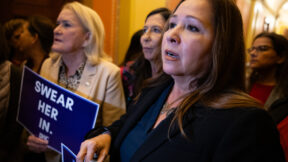Judge Announces He’ll Dismiss Sarah Palin’s Defamation Case vs. NYT — Regardless of Jury Verdict

Spencer Platt/Getty Images.
Former Gov. Sarah Palin (R-AK) was always facing an uphill battle in her defamation lawsuit against The New York Times; it’s very difficult for public figures to win these kinds of cases. On Monday, a federal judge illustrated that concept in unforgiving terms by announcing, in the middle of the jury’s deliberation, that he would be dismissing the case regardless of their verdict.
The issue comes down to well-established case law regarding the burden of proof public figures must meet in order to establish a claim of defamation. As a former governor, vice presidential candidate, and conservative media figure, Palin is without question a “public figure” — and therefore would have had to prove that the Times and editor James Bennet acted with “actual malice” when they published a 2017 editorial that originally claimed a link between a mass shooting and a graphic shared by Palin’s PAC.
Adam Klasfeld at Law & Crime has been following the case and described the editorial thusly:
Before it was corrected, the editorial asserted that the “link to political incitement was clear” when Jared Lee Loughner opened fire more than a decade ago in Tucson, Arizona, killing six people and injuring 13, including Rep. Gabrielle Giffords. The editorial board had been referring to a map disseminated by Palin’s political action committee Sarah PAC, which had stylized crosshairs over the electoral districts of Giffords and 19 other Democrats. No link was ever established between the shooting and the maps.
“The judge’s ruling effectively finds that Palin shouldn’t have made a federal case of an error in a four-year-old editorial that was corrected 12 hours later,” added Klasfeld.
In making his announcement from the bench on Monday, Senior U.S. District Judge Jed Rakoff expressly stated that Palin had failed to prove Bennet and the Times acted with “actual malice.”
In the American legal system, issues relating to the interpretation of law remain with the judge, even in jury trials. The jury’s role is to interpret the facts and decide if the required elements of each legal claim have been met, as defined in the jury instructions.
“I think that there is one essential element that plaintiff has not carried its burden with—the portion of actual malice relating to belief in falsity or reckless disregard in falsity,” said Rakoff. “My job is to decide the law,” he added. “The law sets a very high standard, the court finds that that standard has not been met.”
David Axelrod, the attorney who was representing the Times (Note: this is a different David Axelrod than the former Obama adviser and political commentator), had asserted during his closing arguments that “their speedy correction showed the paper’s then-editors harbored no actual malice, a standard that has been law of the land in defamation cases since the watershed precedent in New York Times vs. Sullivan more than half a century ago,” Klasfeld noted.
“Freedom of the press and freedom of speech are fragile things,” Axelrod had said, adding that “the First Amendment is so important that honest mistakes don’t create liability.”
Rakoff had previously thrown out Palin’s claim for punitive damages, finding her attempts to show any hatred of her on Bennet’s part had fallen short.
Undoubtedly cognizant of the high profile nature of the case, Rakoff stated that he expected Palin “will inevitably” appeal and therefore he would allow the jury to continue their deliberations uninterrupted, in order to allow the Second Circuit Court of Appeals to “greatly benefit” from their interpretation of the facts.




